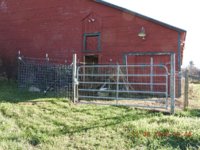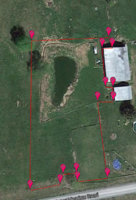Bruce
Herd Master
Dead end is fine, normal actually. The circuit is completed when something touching the ground (*) is also touching the hot wire. If you live somewhere really dry, or where the ground is frozen in the winter, the ground is not a great conductor. I've carried a ground wire 6" below the hot wire on my fence. The posts (steel T-posts except at corners and gates) are 5' out of the ground, the fence is 4' woven wire and the hot runs on top at 5 '. I do not currently have hot wire running over the gates other than the one at the north end of the barn. The hot wire wasn't installed yet when the picture was taken but the energizer is inside between the open door and the closed big doors. The hot wire runs from the right side of the barn overhead to an extension on the right gate post and the gate and the section to the left are just a short run of wire. The main run goes the other way. Note that the red line denotes the "fenced" area, the hot wire stops at the corner of the small barn and there is a gate between the barns on the right. It isn't protected with hot wire and that does concern me.


Note carefully that in @Latestarter's diagram, the energizer is on the left side of the picture. You REALLY don't want the free end of the gate wire to be hot when it is disconnected. As you can see they have a "two way gate anchor" on both posts but the hot wire is connected only to the one on the left. You don't really need a "two way" on the right side, you aren't going to connect anything to the second side if you run the hot wire underground as shown.
BTW I just saw this thread. I wouldn't have ever guessed someone would run 120V straight to the fence wire
* "Ground" is either the actual ground or the metal fence that is clipped to the metal T-posts in the ground.


Note carefully that in @Latestarter's diagram, the energizer is on the left side of the picture. You REALLY don't want the free end of the gate wire to be hot when it is disconnected. As you can see they have a "two way gate anchor" on both posts but the hot wire is connected only to the one on the left. You don't really need a "two way" on the right side, you aren't going to connect anything to the second side if you run the hot wire underground as shown.
BTW I just saw this thread. I wouldn't have ever guessed someone would run 120V straight to the fence wire

* "Ground" is either the actual ground or the metal fence that is clipped to the metal T-posts in the ground.

 won't tell you the second rule
won't tell you the second rule TSC has a very good store display that makes it simple . But there are so many options these days sure has changed over the years .
TSC has a very good store display that makes it simple . But there are so many options these days sure has changed over the years .